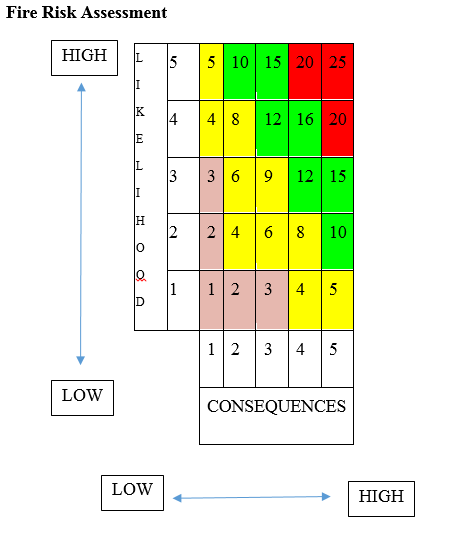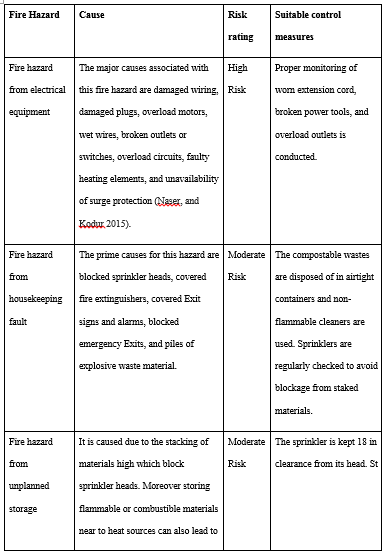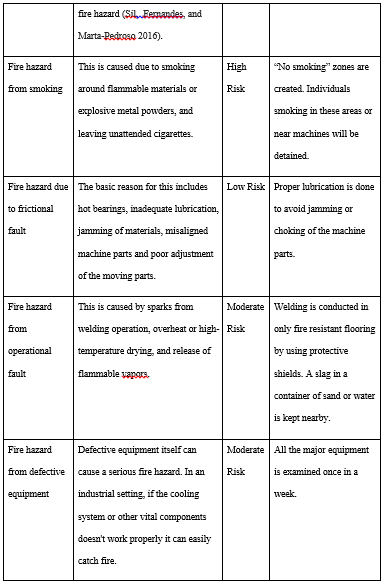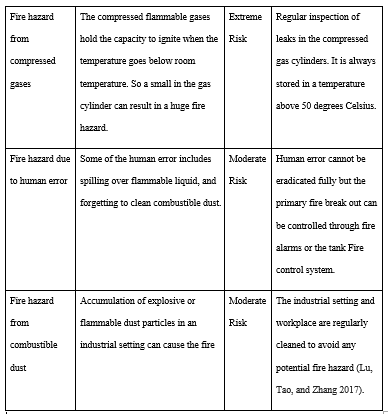Analysis of Fire Hazards and Safety at the Workplace Assignment Help
Write an Inspection report describing the fire hazard/fire safety deficiency/ non-compliances in the building, risk levels, standard/code violated and suggest suitable recommendations in detail.
Dont miss your chance to excel in Analysis of Fire Hazards and Safety at the Workplace Assignment Help ! Hire tutor of Expertsminds.com for perfectly written assignment solutions!
Introduction
The present report illustrates the framework established for the fire hazard and control measures in an industrial building. Fire hazard in an industrial setting can result in assorted damage for the structure, its workers, and the surrounding communities. Moreover, the release of any flammable material at the workplace can lead to a flash fire, a fireball, jet fire, vapour cloud explosion, and pool fire. The disaster mostly occurs due to a lack of awareness and knowledge among the managers and workers. As per a report, 37000 fire accidents occur at the industrial properties per year, which results in approximately 279 civilian injuries, 18 civilian deaths, and $1 billion property damage (Adab, Kanniah, and Solaimani 2015). According to the Oman law blog, specialists should conduct surveillance of fire devices in industrial buildings for at least once in every six months (McBride, and Kent 2019). Based on the regulation of Occupational safety and health, employers should implement a list of measures towards various risks associated with fire. It also suggests that the position of fire extinguisher and fire alarm must be clearly indicated. A fire safety course is provided to the employees for providing them with the basic knowledge of using firefighting and understanding evacuation procedure of the workplace. Furthermore, the risk level of fire hazard should be kept with the "as low as reasonably practicable" (ALARP) (Bonini, Muir, and Blackmore 2016).
Scope of this report
In this report, we will be focusing on the various types of fire hazard probable at the workplace along with rating them in conjunction with the risk level (low to high). First, we will discuss the significance of fire hazard and the adoption of measures in order to control any lethal event. Next, we will discuss the categorization of various fire hazard in terms of low, moderate, high, and extreme, which signifies the level of risk. Down the line, we will recommend measures that must be implemented at the workplace to ensure the safety of employees. Finally, the information presented in this report will be concluded with a note on possible future perspectives.
Significant Fire hazard
Effective fire safety planning and precaution have the potential to reduce the risk of fire hazard occurrence with the help of a fire protection system. Currently, most of the buildings are becoming very complex in structural design. Thus, it requires an effective approach to fire safety and control. According to Bonini et al (2016), industrial occupancy holds the highest rate of annual fire occurrence as compared to other building categories. For this purpose, a survey is conducted on the fire security aspects of the above mentioned industrial building. The survey report revealed that the workplace has a number of fire safety deficiencies. The lack of fire safety system can lead to major fire hazard which can cause manpower as well as economic loss. All the identified fire security deficiencies should be identified, in accordance with the priority level. For instance, the inspection team revealed that the fire sprinkler of the workplace is not working. The fire sprinkler is considered as the foremost instrument as a fire controlling system. According to a report, the presence of a properly maintained automatic fire sprinkler system reduces the chances of dying in a fire by 70% (Mulcahy, Boylan, and Sigmann 2017). The emergency lights, as well as Exit signs, are also missing in the building. The Exit signs and lights should properly work at least during the working hours. During the time of any fire hazard or emergency, these signs act as a rescue guide for the people. Another important issue is related to the fire extinguisher at the workplace. According to Kangavari et al. (2015), the available fire extinguisher in the workplace does not suitably cover possible fire hazards within the surrounding. The fire extinguishers are available in different capacities and sizes for different fire hazards, consisting of varying chemical proportions. A facility should have a portable fire extinguisher which is appropriate to its surroundings. Further, it was observed that some of the unused electrical outlets like junction boxes and circuit breaker panels in the workplace are open and uncovered, and this increases the risk of fire hazard. Lastly, the stairwells and emergency exit doors should be clear from any form of obstruction. This path should be kept clear of obstruction as it helps to leave the building in an emergency situation (Kangavari, Salimi, Nourian 2015).

The risk rating in the risk assessment matrix is calculated by multiplying the likelihood against consequences (Shin, Lee, and Ahmed 2018). In the given risk assessment Matrix, there are basically four categories of risk rating, low risk, medium risk, high risk, and extreme risk. Low risk ranges from 1 to 3. Low-risk rating is mostly acceptable and is subjected to periodical reviews or significant changes (Bonini, Muir, and Blackmore 2016).
Moderate risk ranges from 4 to 9. Medium risk rating can only be tolerated for short term and then requires further control measures for mitigating the risk. The control measures to be planned and introduced within a given period of time. This form of risk is considered as an organization's greatest risk. High risk ranges from 10 to 16. The high-risk activities should be monitored regularly and ceased immediately until the further control measures are introduced for mitigating the risk (Adab, Kanniah, and Solaimani 2015). Extreme risk ranges from 20 to 25. This level of risk activities is highly dangerous for any organization. The associated risk activities should be immediately identified and necessary mitigation strategies should be adopted.
The fire at the workplace starts when there is heat generation due to a deliberate work process or through ignition from combustible material. These fire hazards are preventable by applying suitable safety precautions.
Identified 10 different types of fire hazards are described below (Watts, and Hall 2016):



In order to ensure the safety of the employee and avoid the risk of infrastructure loss due to fire hazards, it is important to consider risk mitigation strategy. For example, Arghami, Kamali, and Mahboubi (2016) have 4identified five key steps that should be used as a checklist for accessing safety and precaution measures. In particular, the sources that can cause a fire should be identified and monitored on a routine basis. Second, the people working at those sites should be ensured for safety measures. Next, the evolution of sites in terms of maintenance, proofing, warning symbols, and escape route should be defined explicitly. Another important step in this regard is the record management and periodical reviewing of the plans. This will ensure that plans were updated and training to employees are maintained thoroughly. Lastly, the review of the risk assessment on a routine basis is important, which should be further documented.
Recommendations
Prevention and control of the fire spread should be of high priority for the owner of the industry. The primary responsibility towards workplace fire safety he's in the hands of employers as well as those in control of the workplace. Regular inspection through Fire department inspectors should be conducted under the specific fire risk assessment. In particular, the employees should follow some fire preventive measures to control the risk.
• It should be ensured that the workplace is equipped with appropriate fire extinguishing equipment, fire alarms, and fire detectors.
• Employees should be properly trained to use the firefighting equipment, contacting external emergency service and proper evacuation (Taylor, and Edwards 2018). Provision of both job-specific and general fire safety training to those working in a potentially hazardous environment.
• Equipment and machinery running for 24 hours a day should be given regular housekeeping to monitor the sparks or static discharge. This will decrease the risk of small spark turning to a big disaster.
• Emergency routes should always be kept clear without any blockage. It should comply with the rules and regulations related to Exit doors and signs.
In addition to this, there should be an identification of the level of fire risk according to the risk assessment matrix. General working policies, such as no smoking should be strictly implemented. There should be minimum use of flammable materials when an alternative is available.
Conclusion
The report has exposed the different faces of fire hazards and its related control measures within an industrial setting. It is important for the employer to achieve a higher degree of safety for its workers, property, and the surrounding community by implementing effective fire safety planning. There should be proper monitoring of sensitive equipment and devices, and work procedures to avoid the risk. As a precautionary measure, there should be a control on ignition sources, good housekeeping, and safe storage of flammable materials. All the equipment, as well as systems, should be kept in proper working condition. This includes maintenance of machinery in the production line and inspecting fire safety systems such as sprinklers and fire extinguishers.
Are you looking for reliable Analysis of Fire Hazards and Safety at the Workplace Assignment Help solution services? Expertsminds.com is right choice as your study partner!